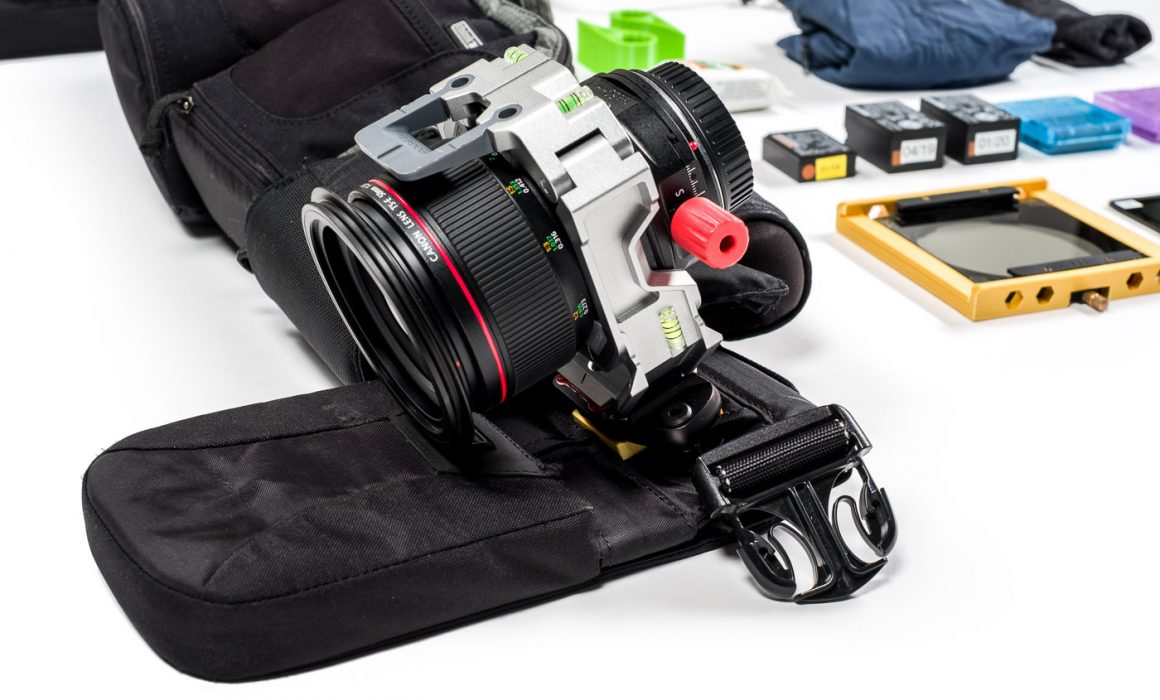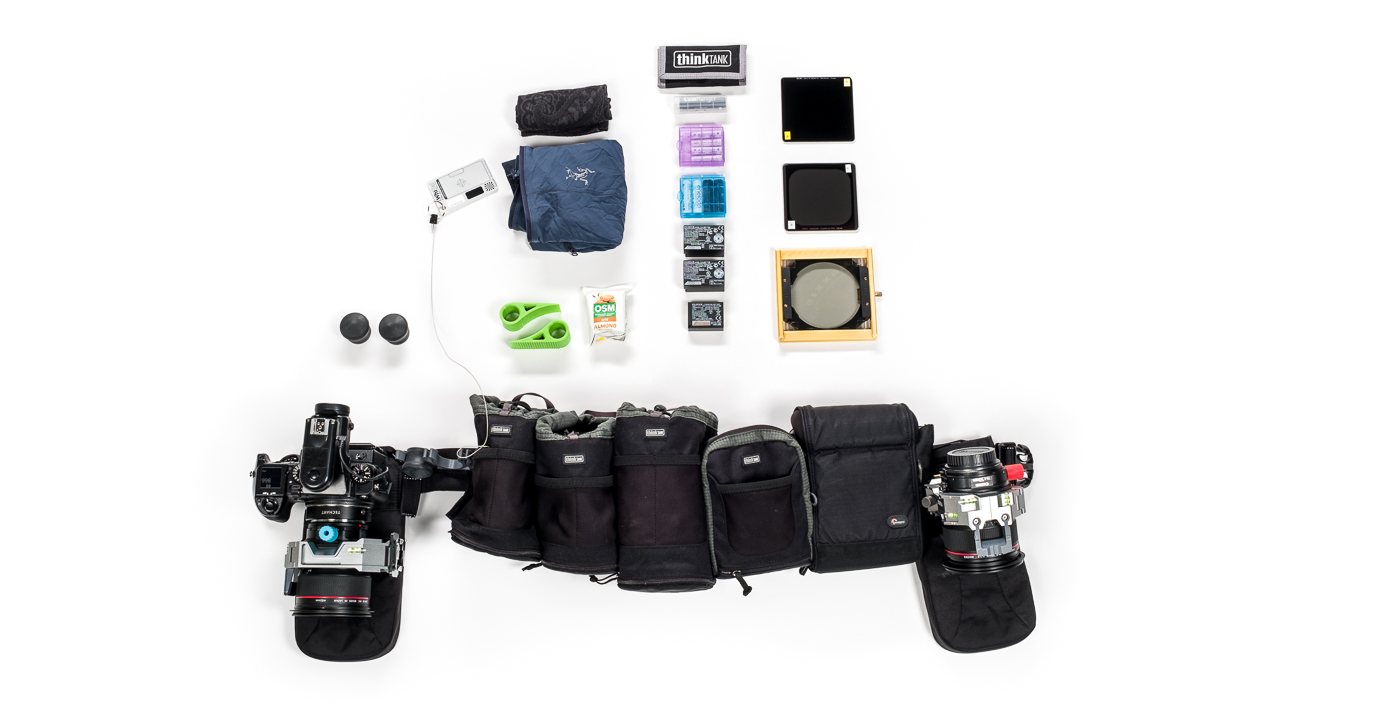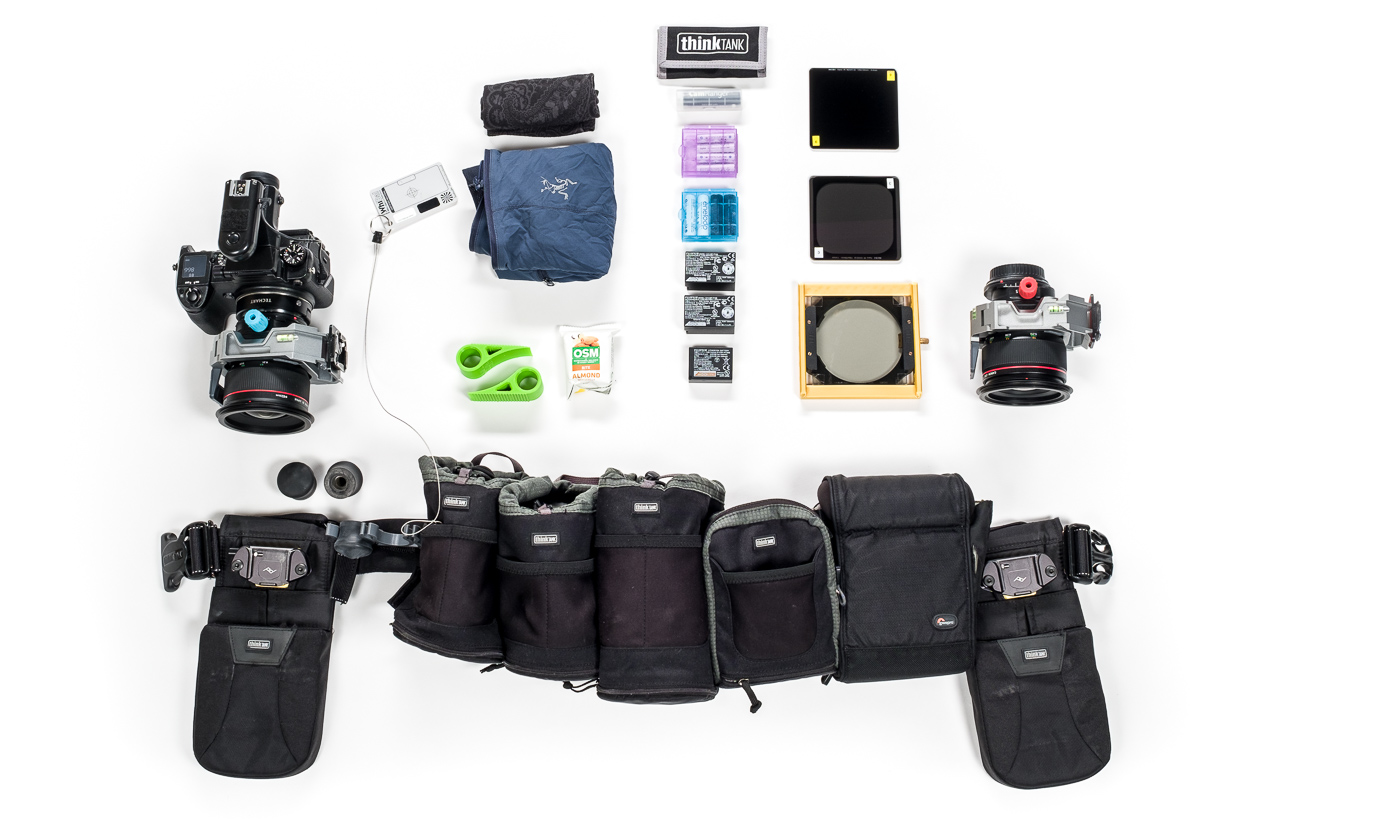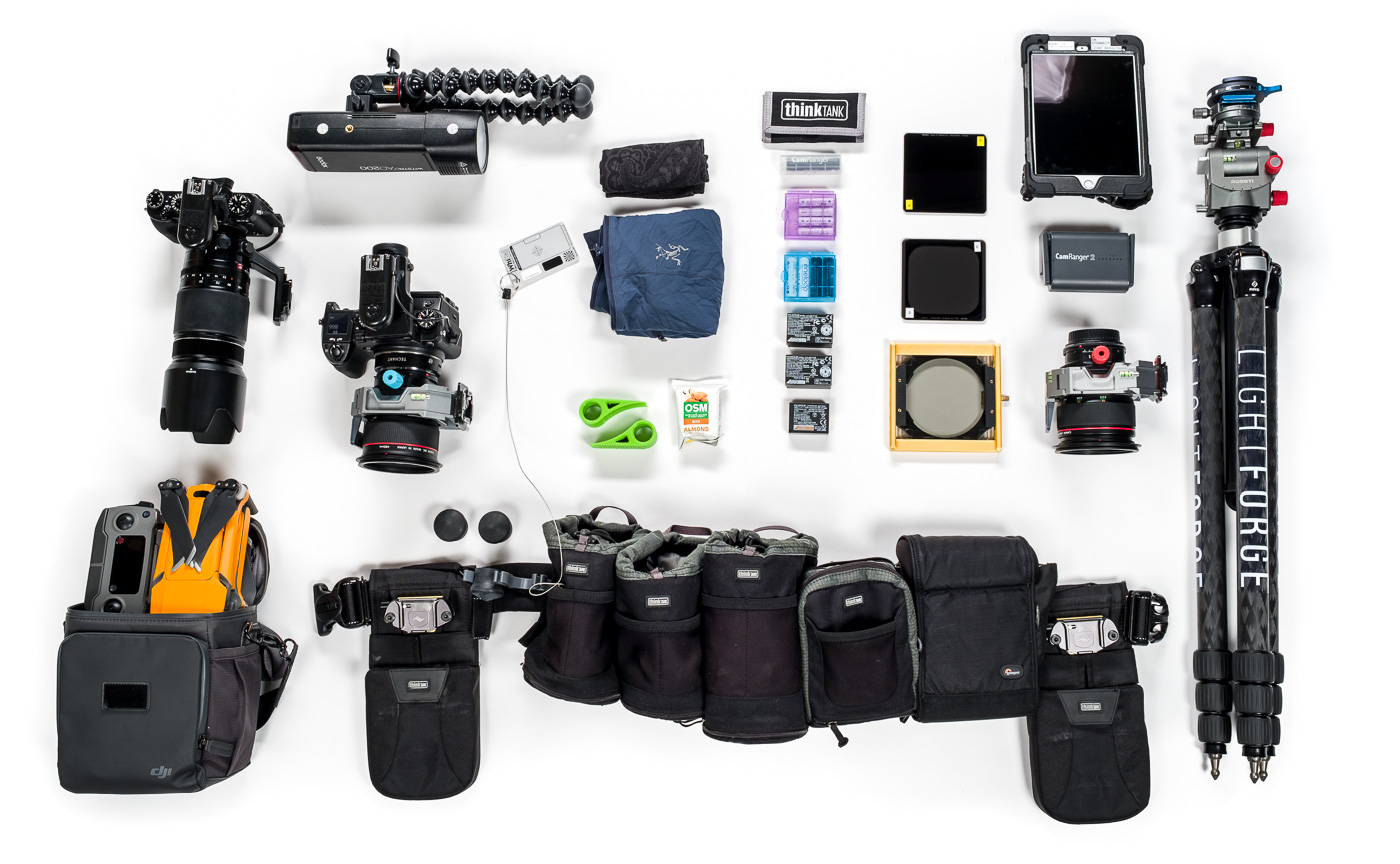The Ergonomics of Shooting Solo
Working Without an Assistant in Architectural Photography
When I first started in professional photography, I was operating on a shoestring budget with no clients. In those early days I was working on the worst-case assumption that it might take years to make the business viable. To stave off starvation I kept expenditure to a minimum. Working as a total newbie in what counts for a medium-sized city in New Zealand, squeezing an assistant out of the budget was something I didn’t even consider. The money would have come straight out of my mostly empty pockets.
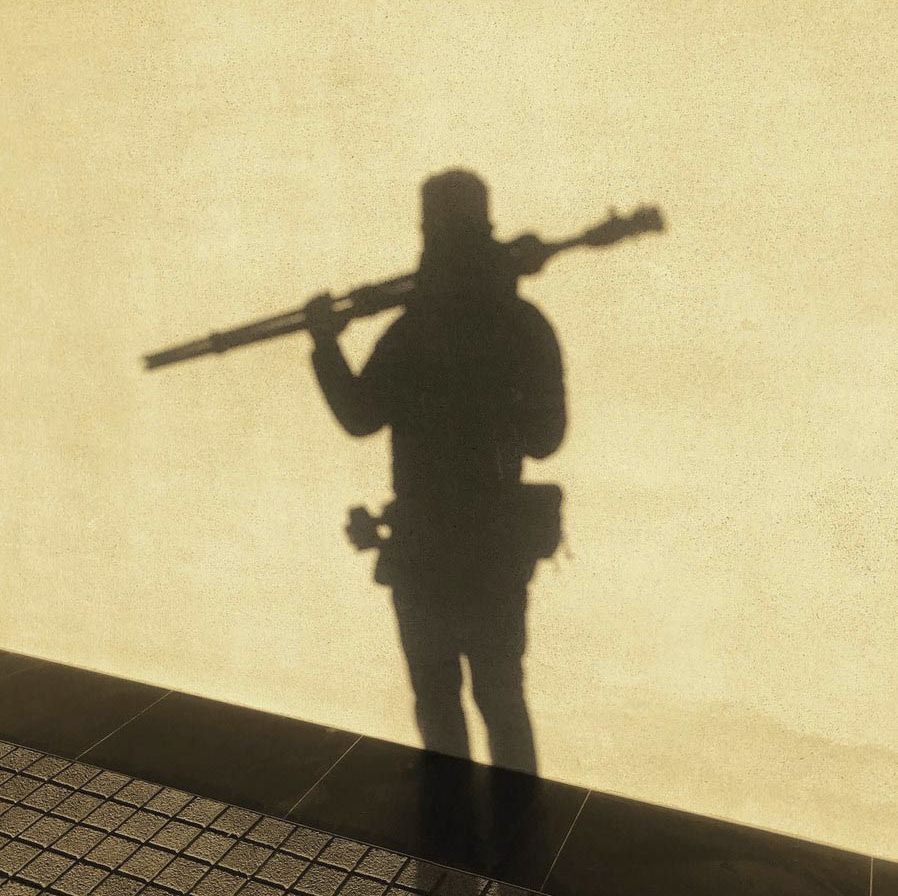
Captain and second in command
Given these limitations, I adapted to working by myself. Over the years I selected all equipment for portability. As projects and clients got bigger, I eventually dropped all other subject matters in favour of working architectural projects fulltime. Ever since I have been faced with the strategic decision of where I want to point the boat: Working with an assistant had become an option, but did I want to go there?
Assistant vs Helper
At this point I have to differentiate my definition of an assistant somewhat. Many of my shoots, especially where educational facilities are concerned, absolutely require some outside help, otherwise I would spend my entire time moving furniture around. This ‘give me a hand’ type of assistance does not require any knowledge about photography or lighting, so for most parts any warm body will do. I usually offer my clients the choice of hiring someone, but in almost every single instance they opt for providing someone from their own staff. I doubt this decision is economically driven, considering the hourly rate of an architect. The benefit to my clients lies in the opportunity to collaborate and have greater influence on the outcome. With this type of close collaboration everyone is a winner. The client can give some art direction while watching live results on my iPad/Camranger setup, while I get a helping hand and the opportunity for a little bonding.
Pros and Cons
Would I love someone to jockey lights, lenses and camera gear? Sure thing! I’m not getting younger, and carrying equipment around all day has caused me various issues with neck and joint pain before I had all my gear optimised. Looking at other photographers’ Instagram in their light summer shirts, carrying just a camera with one lens admittedly makes me a little jealous. Why again am I weighing myself down like a mule?
Typical loadout that I take everywhere in and on my belt, camera and lenses attached
What these glittery Instagram images don’t show is the professional assistant and the piles of equipment. Some photographers with workflows that heavily rely on lots of added light will bring more than one assistant. Check out Scott Hargis’ Instagram and be amazed by the 100 pounds of equipment and a fully tethered laptop that he and his assistants seem to carry around for some shoots. I am sure that Scott’s strategy is perfectly adapted to his market and style, after all he has been at it for ages. But I always felt like that strategy would not work for me.
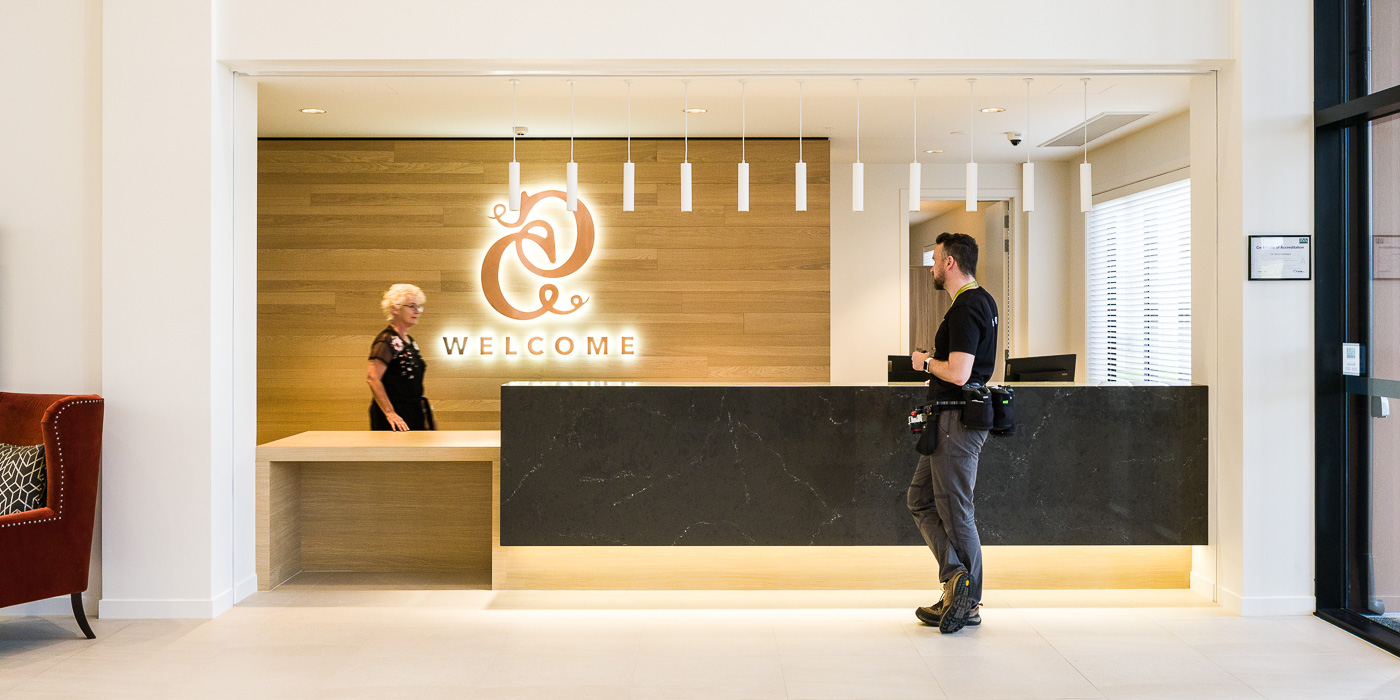
encouraging the talent, released with radio trigger
First of all I doubt it could work in my area, as the budgets simply aren’t there. Then there’s the strategic component of how I consider extreme flexibility to be part of my service. I push shoots a lot to wait out bad weather conditions, and I wouldn’t want to manage a comet trail of freelance assistants in the wake of spontaneous schedule changes. Instead, at least for out-of-town work, I will just bring one monolight, a Camranger and an iPad Mini that fits into one of my many belt pouches. This choice results in simplicity (fewer people, less stuff to consider) and flexibility. In terms of economics I either get to keep the money that would have gone to an assistant, or alternatively I gain a competitive edge by being able to offer the same service at a lower price point. The flipside is that I spend more time running around and at the computer because I’m not setting up a perfectly lit scene with an assistant. Where extra light is required, I will composite from multiple manually lit source images that I overlay in Photoshop.
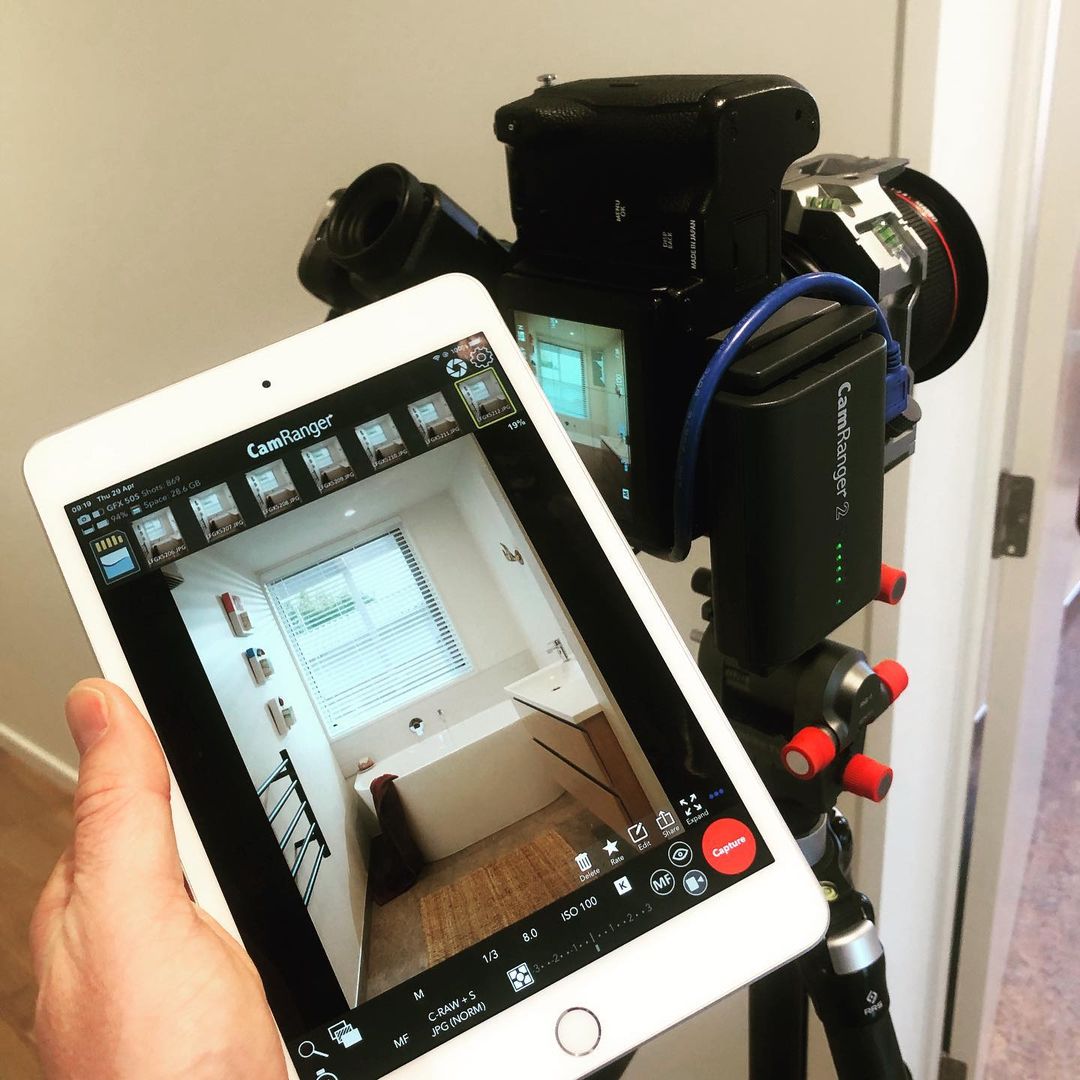
assistant skimping device
Is my approach better? Absolutely not! But it seems to works for my desired look and within my local market. It also keep my business slim and more adaptable. It all comes down to personal choice.
Pro
Flexibility
Cost savings
Competitive edge
Con
Harder work on location
Harder work in post
The style police might get you
Workflow and Equipment
So how do I go about making my solo excursions happen? Portability and good ergonomics are everything. I choose my equipment with an eye on being able to handle all of it by myself. I also make sure that I work sustainably. At 42 my body is not as forgiving as it used to be, so I keep an eye on carrying my equipment as ergonomically as possible. I look for:
1. Ease of carry
2. Low weight
3. Versatility
4. No wires
Think Tank Belt System
My batman belt is my favourite piece of equipment. I tried backpacks (cumbersome, time consuming, hot), shoulder bags (back pain, fumbly), and never even gave roller bags a chance. I’m simply moving around too much. Dragging a mini fridge full of equipment around with me would quickly get on my nerves. My large Think Tank production cases either stay in the car or at a staging area within the building.
Think Tank’s belt system is extremely versatile and comes a wide range of pouches. As the way I shoot changed over the years, I added and removed little bits on my belt. I love how it sits on my hips in my centre of gravity, rather than hanging off one side. I can carry it around fully loaded with only minimal discomfort after long, hot days. Recently, I went from dual spikes on my tripod (the ones that screw up and down the spike) to dedicated steel spikes and lose rubber caps. I designed and 3D-printed a custom holder for the rubber caps that I attached to the belt. I just love the adaptability!
Gizmos living on my belt fulltime:
– Fujifilm GFX50S
– Canon 24mm TS-E
– Canon 50mm TS-E
– Filter pouch (polariser, a few ND filters)
– Spare batteries for both cameras and all other equipment
– Cleaning cloth
– Grey card on retractable lanyard
– Door wedges (3d printed)
– Neck warmer (Buff)
– A thin running vest for when it gets windy
– Snacks and aspirin
– Rubber caps for my tripod spikes (to protect flooring from scratches and carried-in dirt)
– Phone
Full-time gizmos with camera and lenses detached. The large pads allow the camera to rest on a nice soft pad rather than my nice soft legs
Part-time equipment:
– Camranger 2
– iPad Mini
– Fujifilm X-T3 with XF50-140
The biggest downside to the belt is that it might get you in trouble with the style police. It’s a rather unique look, so if style points are of importance this is not the system for you. The biggest pratical negative is that the belt adds bulk and it can be hard to squeeze through narrow passages. When shooting in one area for long I will sometimes just drop it on a table.
Camera
While my Fujifilm GFX50S with two Canon TS-E lenses is not exactly the lightest equipment in the world, this setup allows me to replace a bunch of lenses. I shoot almost all my work with these two lenses at two different crop factors (resulting in a full-frame equivalent of 50mm@30MP, ~35mm@51MP, 24mm@30MP and ~19mm@51MP; details here) and will only supplement a Fujifilm X-T3 with a XF50-140 tele lens when I need to zoom in on something. Most of the time the X-T3 stays in the car.
The GFX50S is equipped with an optional Fujifilm tilt adapter that enables me to adjust the EVF to where my head is, not the other way around. No more awkward squatting to see through the viewfinder. The tilt adapter adds a lot of comfort to my shooting experience.
All my camera bodies and lenses attach to my belt with Peak Design Capture Clips, freeing my hands for handsy stuff. This also allows me to have all lenses securely attached to me while I change lenses. Previously I fumbled my lens changes once or twice a year, which resulted in annoying repairs.
I stay away from camera straps because they end up flapping in the wind, jostling the tripod in the process. New Zealand is rather breezy!
Tripod
I tried different tripods over the years. My Manfrotto MT057C4 did a fabulous job for many moons. It can be extended to over two metres to shoot over fences or on steep slopes and stairs. Having a very tall tripod with me at all times is important, because let’s face it: I’m not going to run to the car every time I need a longer tripod.
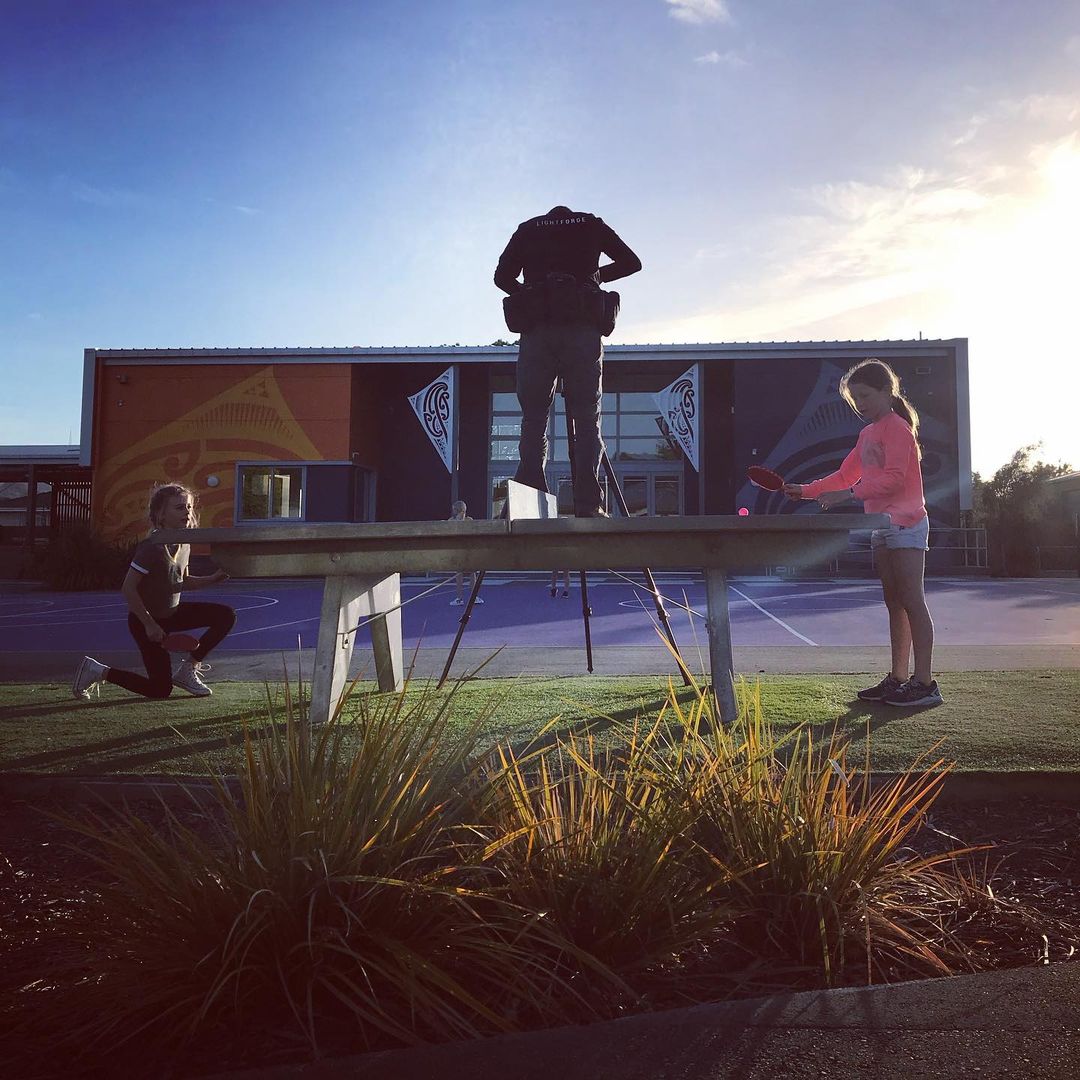
photo credit @kamomarsh
The only problem with the Manfrotto was that it weighed as much as a small child. Over the years this weight caused me constant neck strain. After long deliberation I recently replaced my Manfrotto with a horrendously expensive RRS TVC-24L which does the same job at a little over half the weight. Seriously, you cannot overspend on your health. No regrets!
A centre column is another huge comfort factor. In landscape photography I prefer shooting tripods without centre columns since I adjust up my tripod two or three times in a day rather than a hundred times as in architecture. Being able to make fast adjustments is both a huge time saver and it is easier on the neck.
Drone
I postponed my drone purchase for many years because existing drones were either too cumbersome (DJI Phantom, Inspire) or delivered sub-par stills quality (DJI Mavic 1). When the DJI Mavic 2 Pro was released I immediately ordered one because it offered a good compromise of size, weight and image quality. On some shoots I will carry it on my back for hours on end without even noticing it. Great piece of equipment!
Lights
I work with a 600Ws Godox AD600 Pro light and three smaller 200Ws Godox AD200 lights. The 200s are only useful in very small, contained environments. I often use them to light up adjacent rooms to the areas that I’m shooting in (to brighten up doorways, for example). They are small enough to fit into my pouches with attached Gorillapods and are easy enough to move over to light stands. It’s easy and convenient to carry them around for a quick light accent.
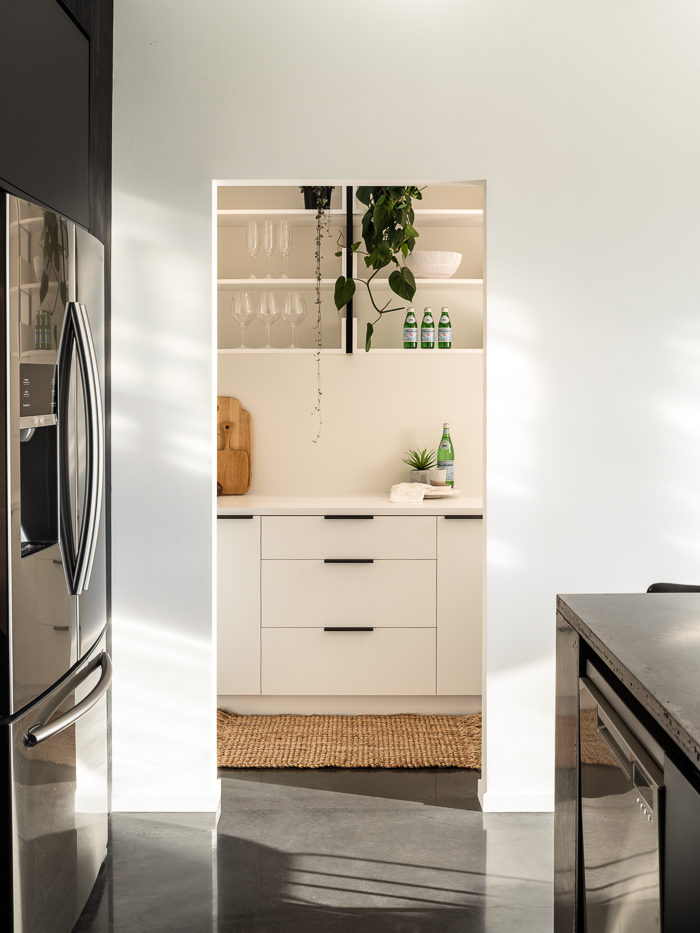
AD200 delivering a kiss of light from its gorillapod
The AD600 Pro is my big beast that I use for medium sized spaces like large homes or semi-closeups in larger spaces. It puts out a lot of light and is the only light that comes on flights with me. Ever since I moved to medium format, 600Ws of light are barely workable, though. A strobe one or two stops brighter would be nice, but external battery packs violate my law of mobility. So I make due with what the AD600 Pro can put out. Luckily, my work has increasingly shifted to large commercial and civic spaces that are almost entirely shot in ambient light. I doubt that even a 2400Ws light would make a difference in these huge environments. For residential work the AD600 Pro is powerful enough.
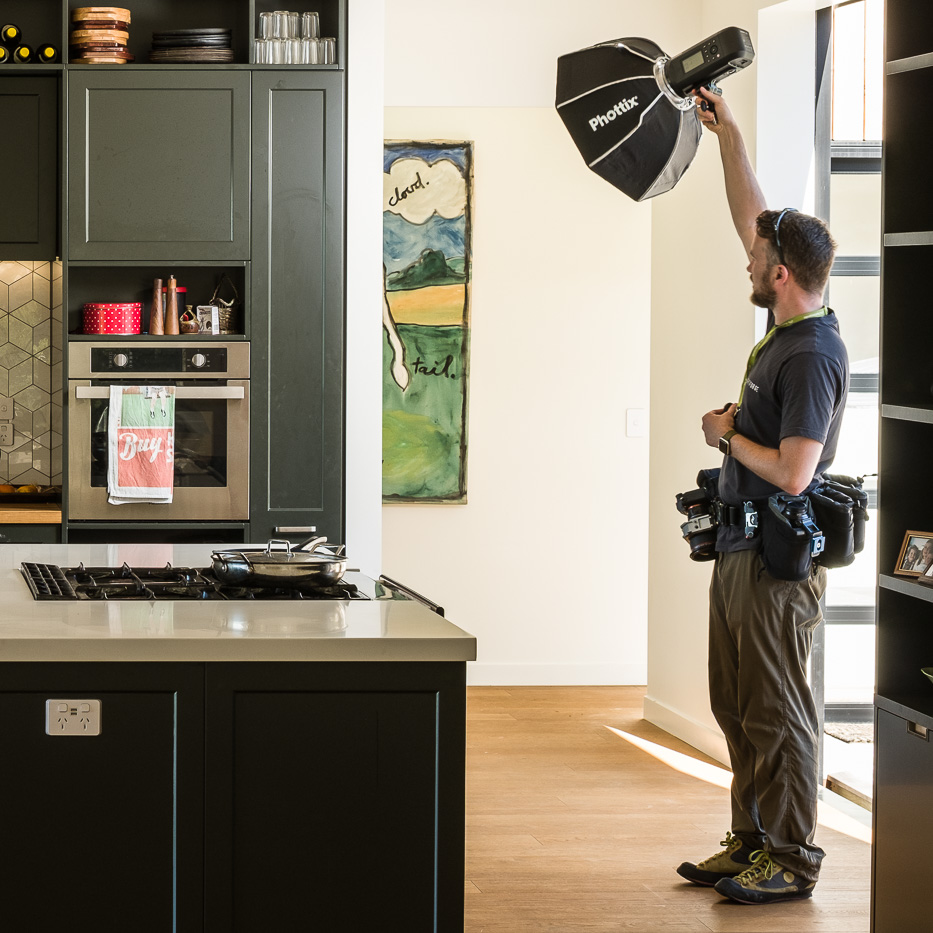
Human light stand
Pants
Is he really going to talk about pants? Yes, he is! Go for stretchy ones. I understand the desire for fashion statements, but nothing beats comfort on a long day. I particularly love my Kühl travel pants. They look like normal pants but have stretch gussets that allow me to gracefully squat into low shots without strangling my nether regions.
Shoes
Be nice to your feet! Comfy, grippy and waterproof will do it. I always manage to end up backed into wet landscaping, ideally on a steep, muddy hillside. Best to be prepared!
The extended universe of things that I carry around with me. Not necessarily all at the same time, but everything fits into the belt (excluding drone and tripod). CLICK IMAGE FOR LABELED VERSION
Final Thoughts
To sum it up, the ergonomics of shooting architecture solo rely on keeping my equipment footprint as small as possible and handling that equipment in a way that puts little physical strain on me. The more comfortable I am, the longer I am able to keep my head in the game and produce good work. Whether it is a large project in the city or a small one in a remote location, being able to attach my gear to myself and go on extended walks opens up extra compositions that would not happen otherwise. In hot interiors I sometimes drop the belt for a few minutes, only to be immediately annoyed by not having everything within easy reach. Nothing beats the convenience of a dozen pockets.
Every now and then a shoot turns out to be more tiring than expected and I decide that I need to hire an assistant for my next big project. Yet somehow it never happens. I either manage to convince myself that a certain job can easily be done solo, the budget doesn’t allow for it, a client offered to help, I already have enough other moving parts to deal with, or I’m simply too stingy. The hard times at the start of my business are long behind me, yet some of the mindset persists.
Another consideration is competition. I have spoken to photographers who feel that today’s assistant will be tomorrow’s competitor. I have sympathy for that concern, especially in small markets like New Zealand, but I’m of two minds about this issue. I can see how this would apply to advertising photography with big budgets and a huge degree of complexity. Architectural photography production is by no means simple, but the principles of freelance architectural work should be easy enough to figure out. The simple act of joining me on a shoot is not going to reveal any great industry secrets. A Mike Kelley tutorial would provide much easier access to wisdom.
What are your thoughts on going solo vs working with an assistant? Drop me a note!

